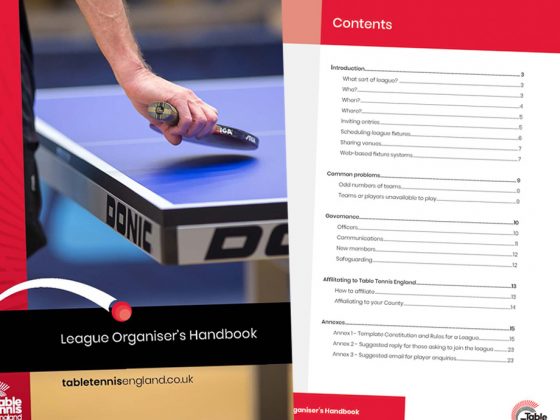Table Tennis England today publishes its League Organiser’s Handbook, a guide packed with information to help anyone organise a local table tennis league.
Written by National Council Chair Estyn Williams, alongside Members’ Advisory Group Chair Neil Hurford, with help from Table Tennis England staff Jo Keay-Blyth and Claire Warner, the guide covers all aspects of local leagues, from playing formats to venues and committee structures to affiliation.
It includes a section on common problems experienced by league administrators and how to solve them, as well as resources including a template constitution and rules document.
The handbook can be downloaded at the foot of this page.
Estyn said: “Local leagues have provided thousands of players with their first experience of competitive table tennis. They depend on volunteers amongst their members to help run them. I think many more members will be prepared to volunteer if they know what is involved.
“I hope the new League Organiser’s Handbook will give volunteers the confidence to help organise existing local leagues and to found new ones.”
Neil has been a volunteer member of the TT Leagues project team – which created a free league management platform for use by Table Tennis England affiliated leagues – since its inception
He said: “I was delighted when Estyn suggested producing a handbook for league organisers. I immediately agreed to help as it fills an important gap that I have become increasingly aware of.
“In my support role for TT Leagues, I deal with queries from leagues all the time. Whilst many of these relate to the detailed operation of TT Leagues, many touch on more general issues such as how to generate fixture lists that avoid fixture clashes or the thorny issue of how to deal with postponements.
“So it is very helpful to have this handbook that deals with the key aspects of setting up and managing a league competition. In particular, producing the handbook has prompted me to make the fixture grids that underlie the fixture generation process easily accessible as a downloadable file.
“Estyn is to be congratulated in doing all the heavy lifting in producing the handbook. In addition to league set up and management, he has covered such vital aspects as governance, safeguarding, and communications.
“The ‘model rules’ for leagues will form a great template not only for new leagues but also for existing leagues to check that their existing rules are sufficiently comprehensive.”





